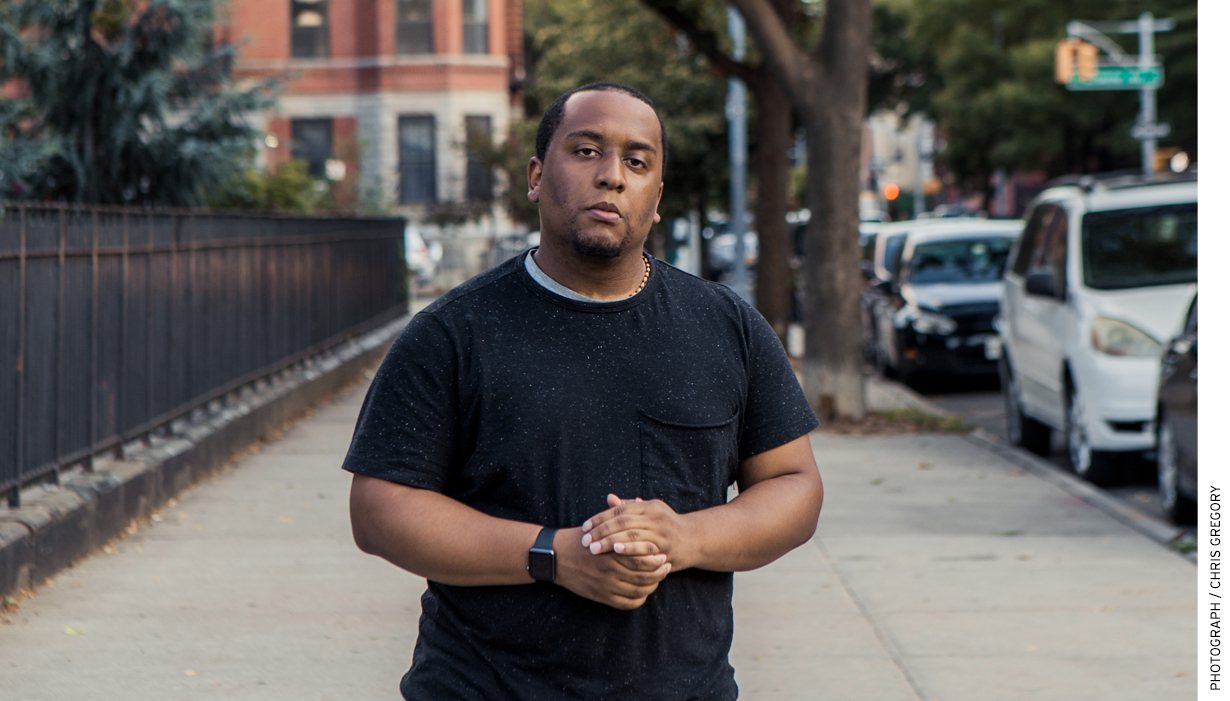
Reynold Essor was sure of two things when he got his high-school diploma last spring: he wanted to get out of Brooklyn, and he wanted to go to college. Earning a degree, his counselors told him, “can help get more money in your pocket.”
So he headed to SUNY Adirondack, a public two-year community college in upstate New York that describes itself as “a leader in the region’s workforce development, preparing the next generation of leaders for a bright future.” The bucolic campus included a comfortable residence hall, leafy grounds, a restaurant run by students, and even a zipline—all featured prominently on its website and brochures. Essor could apply for federal student-loan programs to help pay his tuition, and a non-competitive, open admission policy took the pressure off of his 2.6 GPA to win acceptance.
Less prominent in the school’s pitch were the relatively long odds of earning a degree in three years: about one in four at SUNY Adirondack, in line with the 21 percent average at all 1,462 community colleges in the United States. The national six-year completion rate stands at 39 percent, on average. Part of the reason is that community colleges, with their commitment to open access, admit millions of students each year who are unprepared for college-level work, even though they have earned a high-school diploma.
For decades, despite those daunting statistics, the schools had a built-in base of students attracted to their open doors and relative affordability. But enrollment at public two-year college has dropped by about 10 percent nationwide in recent years. Decreases in state funding and widespread tuition increases have hit a stagnating middle class. And a new emphasis on outcomes-based funding is putting pressure on public colleges in some states to show results.
A hard look at outcomes raises questions about the mission and promise of community colleges, not to mention the meaning of a high-school degree. Would funding commmunity colleges based on outcomes lead them to serve students better? Or would they instead water down standards or ignore students most in need of a leg up? At what point does a commitment to open access become a license to enroll students unlikely to succeed? Is “college for everyone” really college at all?
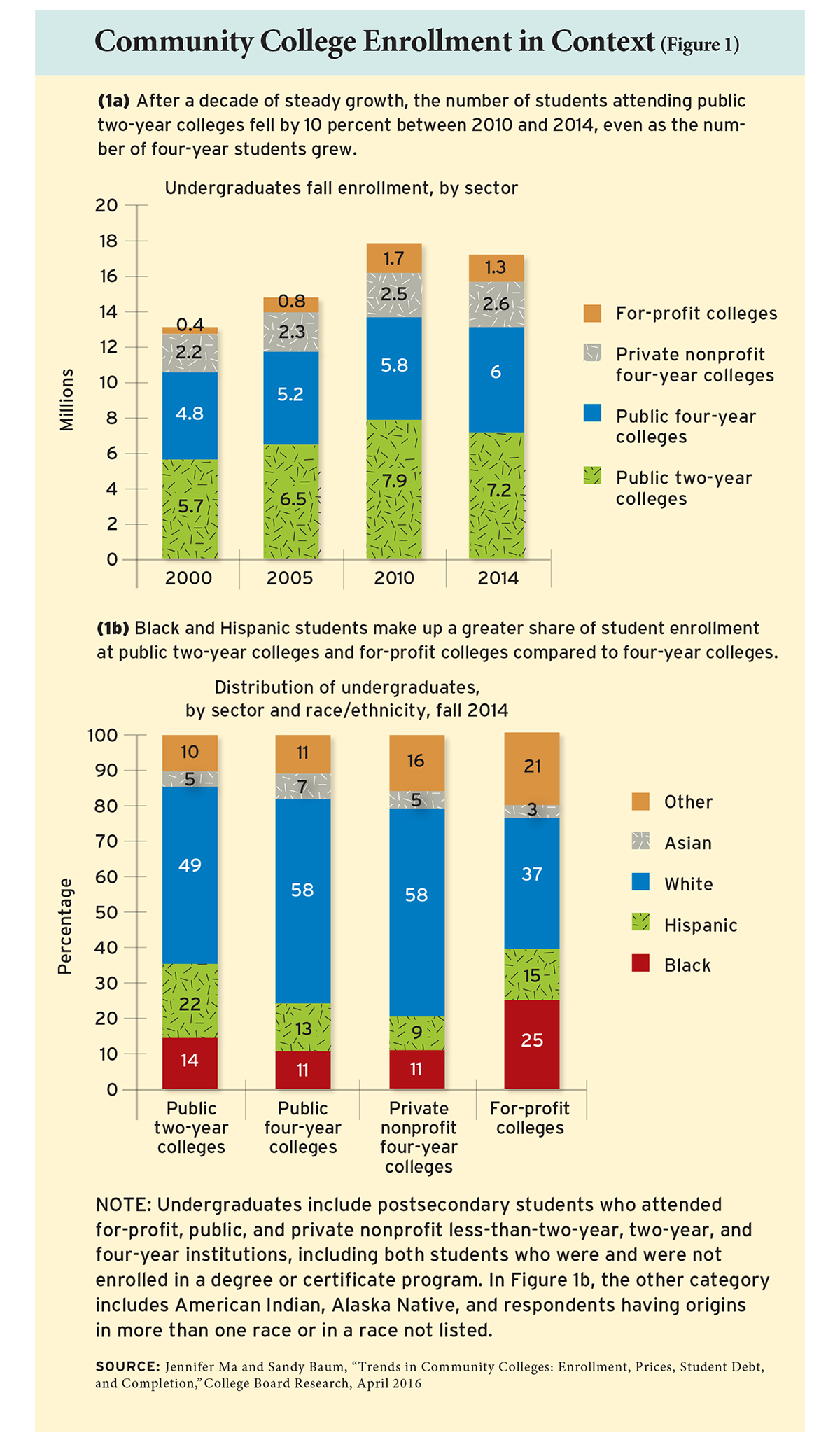
The Remediation Trap
Community colleges enroll about a third of undergraduate students in the United States, and their goals, profiles, and levels of preparedness are dizzying in their diversity (see Figure 1). About one in four two-year schools is private, and about the same number now offer dorm-style campus housing. They enroll a disproportionate share of low-income, first-generation, and minority students, and have become a popular symbol of bootstrapping and upward mobility, inspiring leaders from former president Barack Obama to Tennessee governor Bill Haslam to propose making them tuition-free.
To be sure, many students do not enroll with an associate’s degree in mind: community colleges offer professional training and credentials, lower-cost academic basics for students who move on to four-year schools, and other opportunities for skill aquisition or intellectual exploration. But for millions, the schools are the primary point of entry to the higher-education system, especially in light of the shrinking non-competitive for-profit sector. And their mission, to extend an open invitation to any high-school graduate looking for an educational leg up, is complicated by the reality students face once they get to campus.
Non-selective admission policies may get students through the front door, but they don’t necessarily allow students to enter a college classroom right away. First, the schools administer “readiness” tests in math and English, which students must pass before they can enroll in credit-bearing classes. Students who cannot pass the tests are required to enroll in remedial courses, to master material that, at least according to the college, they should have learned in high school.
That’s what happened to Essor, who landed on the remedial track after falling short on the placement exam at SUNY Adirondack. He spent two semesters taking, and then retaking, three required remedial courses. He used financial aid, including a federal Pell Grant, to cover the costs, is now a year behind his planned timeline for graduation, and earned no credit for his effort.
It’s a common scenario. While estimates vary, a review of student transcripts from 2003 to 2009 found that 68 percent of students at two-year public colleges took at least one remedial class, with higher rates among low-income, black, and Hispanic students (see Figure 2). Students spend an estimated $7 billion annually on remedial college classes. Yet only half of enrolled students complete remedial courses, and about one in seven completes a credential within six years.
Essor believes the source of his trouble is his high-school education. “I passed without learning,” he said. And despite being counseled in high school to take college-placement tests, and even taking an exam-prep class before graduation, he said he didn’t understand his academic weaknesses or how to correct them until it was too late.
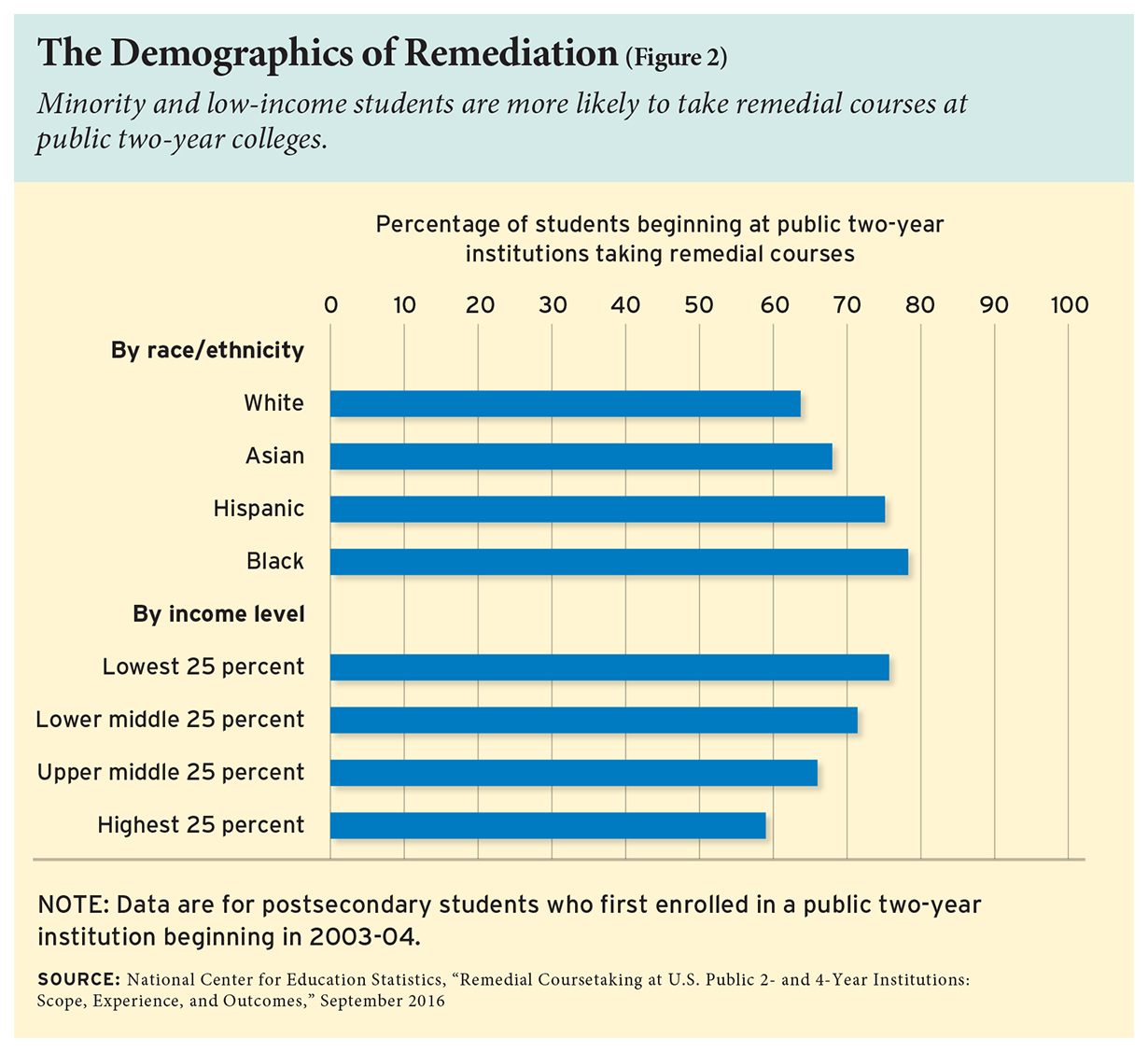
The Disconnected High-School Diploma
Overall, just 37 percent of high-school students met college-ready standards in math and reading on the 2015 National Assessment of Educational Progress. Meanwhile, the high-school graduation rate was 83 percent that year, with 69 percent of graduates heading straight to college.
This illustrates the “misalignment” between graduation standards at the K–12 level and the definition of “college readiness” at community colleges, both of which can further differ from state to state, said Nikki Edgecombe, senior research scientist at the Community College Research Center (CCRC) at Teachers College, Columbia University.
Arriving to college unprepared can spell financial trouble for community-college students, who tend to borrow less for their education but are more likely to default on their student debt. While the average student debt load is just $3,700, one in five community-college students defaults on that debt, twice the rate of students at four-year schools. About 36 percent of all federal Pell Grants go to students at public two-year schools, totaling $10.5 billion in 2012–13.
Richard Kahlenberg, senior fellow at the Century Foundation, is one of several education researchers and analysts suggesting that one solution lies in creating a tiered high-school diploma system, where one is “for everyone, connected to an exit exam,” and another is based on “demonstrating core competencies” needed for success in college (see “Rethinking the High School Diploma,” forum, Winter 2015). High schools would tell students that the second diploma could help them avoid losing time and money in college, because they could avoid expensive remedial courses. They would also need to build in support for students who aim for the college-readiness diploma but struggle.
“The political system won’t support high rates of failure,” said Kahlenberg, so this change would avoid massive decreases in high-school graduation rates, while giving students “incentive to work harder.”
Another strategy, the college- and career-ready Common Core State Standards, has run into political opposition and uneven implementation from state to state. This year, fewer than two dozen states are administering Common Core–aligned exams to high-school students, nine fewer than two years earlier.
Other efforts to make high-school graduation requirements more rigorous are running into trouble as well, now that they are about to make headlines for real students. In Ohio, for example, a projected one in three high-school juniors is expected to fall short of new graduation requirements that take effect in May 2018 and require that they earn passing scores on seven new end-of-course exams. State officials are debating ways to allow students to graduate anyway, such as considering attendance records or substituting community service and capstone project requirements for test results.
Meanwhile, a growing share of high-school graduates have sought college degrees in recent decades, with much of that growth at community colleges, where enrollment peaked at 7.9 million in 2010. This change occurred as the achievement gap in K–12 persisted, fueled by continued racial and economic segregation, with fewer resources going to schools with substantial minority populations, said Kahlenberg of the Century Foundation. Community-college students are far more likely than their counterparts at four-year schools to be Hispanic or black and from a low-income household.
“The trend of college-going continued to rise—especially of low-income, minority students—but on the whole, there haven’t been dramatic changes in the K–12 system to accommodate these changes,” said Edgecombe.
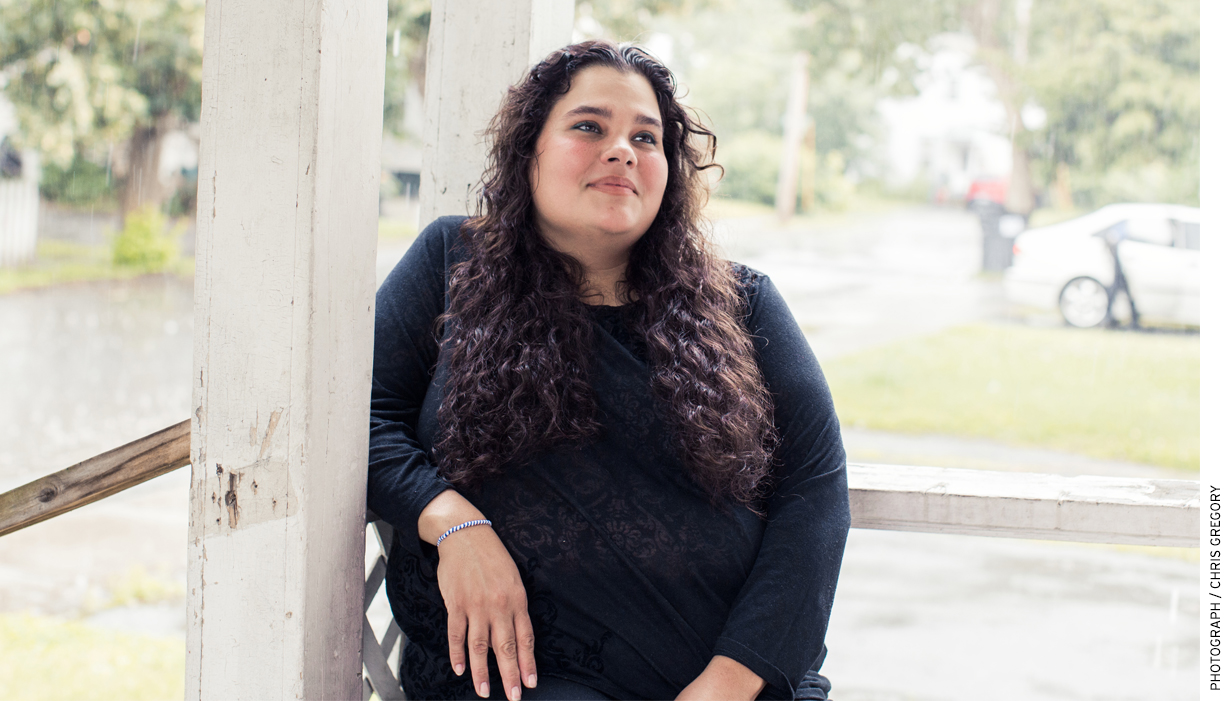
Non-Traditional Students, Unique Needs
Many students have another problem: fuzzy academic skills, thanks to years lapsed between high school and college. The average age for community college students is 29, and nearly half are age 25 or older. Most have been out of high school for some time and face myriad challenges when it comes to succeeding in college—including being savvy about the importance of college-placement tests.
Consider Hope Newman-Heck. Now 34, the mother of two dropped out of high school long ago. Several years later, she was living in Queens, New York, and working at a Hale and Hearty Soups restaurant. She decided to study for a GED-style diploma when she found herself unable to help her son with his 5th-grade English homework. With the help of a local nonprofit organization, she got her diploma in 2014.
To her surprise, she said, “People there said, ‘You don’t need to stop here … This is a doorway to other opportunities.’” That gave her the idea that earning a high-enough score on her high-school diploma equivalency exam was all she needed to get into college. The program staff “didn’t even mention remedial courses.”
She decided to enroll at SUNY Adirondack community college soon after earning her diploma because it fit the practicalities of a parent: she knew the area, and the school offered a good childcare program for her young daughter. When she talked with an adviser at the school, the conversation covered subjects like the required number of credits, financial aid, and “a test to see where you’re at,” she recalled. The school’s website counsels that the tests will place students in the classes where they will have “the greatest opportunity to succeed,” and that “the level of first-semester courses can greatly affect the amount of time required to graduate as well as the total cost of your education.”
But Newman-Heck did not grasp the sweeping consequences of the required ACCUPLACER test—that “you have to score a certain amount of points to get to take classes,” she said. “They also don’t tell you your Pell Grant money will go to pay for remedial classes that don’t count against your diploma.”
“That student’s experience has a ring of truth to it,” said John Jablonski, vice president of academic affairs at SUNY Adirondack. The school has “totally overhauled the system of academic advising” in the last year, he said, including training and paying faculty members who have aptitudes for advising so that they in turn can help students “map out how much time and money it will take to complete a degree.” SUNY Adirondack has also developed “YouTube-style” videos created by the math faculty to help students prepare for math-placement exams. The school will start to gather data tracking the impact of these changes this year, Jablonski said.
Newman-Heck’s experience is not uncommon. According to a 2010 study by WestEd, many community-college students don’t receive clear information about what a school will expect of them academically or fully understand the course-placement process, including the assessment exams that can sign them up for semesters of noncredit remedial work. And not surprisingly, they don’t tend to seek help or prepare effectively for it. Another study found 70 percent of students did not study for placement tests, even though many of the schools—including SUNY Adirondack—offer study aids, such as free review classes, online tutorials, and other materials.
The day of the test, Newman-Heck panicked.
“It’s like four years of high-school English in one test … and on math … I didn’t know anything about algebra,” she said. The school told her the scores meant she would have to take remedial classes. “This is horrible!” she recalled thinking. “Should I even continue?” She persisted, because “I wanted to show my son I could do it,” she said.
Now, nearly three years later, she has taken out $15,000 in loans and requested a leave of absence from her current job as a security guard at an amusement park in order to devote more time to school. If Newman-Heck succeeds, it will take her at least four years to obtain a two-year degree.
“Why would they set you up to fail?” she said. “The college tells them, ‘Come on and come to our college’—and then when they don’t pass the placement exam, they get stuck with the bill.”
Looking to High School for Reforms
How can more students complete their community-college studies and earn a credential? Should reform start with American high schools, community colleges, or both?
Newman-Heck landed on one strand of reform when reflecting on her experience to date: “The system” should inform students while they’re still in high school what’s at stake if they’re struggling in math and English, and community colleges should tell applicants “how serious” placement exams are and help them study beforehand, she said.
That is one strategy becoming more popular at community colleges nationwide, including SUNY Adirondack, which has, in the last two years, begun collaborating with local high schools to allow students to take practice math-placement tests and classes to brush up their skills before graduation. Some states, including South Dakota and Florida, have made college-placement tests available to high-school students. In Florida, low-performing students are required to take a college-placement exam in 11th grade and complete remedial work in high school if they don’t pass.
Several states focused on reform at the high-school level are looking to support student preparedness based on their ACT scores. In Tennessee, K–12 teachers and college faculty have worked together to create math and English coursework for high-school seniors who take the ACT test as juniors and score below a certain point. The idea is for these students to catch up in their last year of high school, and begin college with courses that count toward a degree. In three years, the number of Tennessee students needing to take remedial math in college has dropped by 15.6 percent, according to the state’s records. The English program is still in its pilot phase. Both programs have yet to reach all the state’s students.
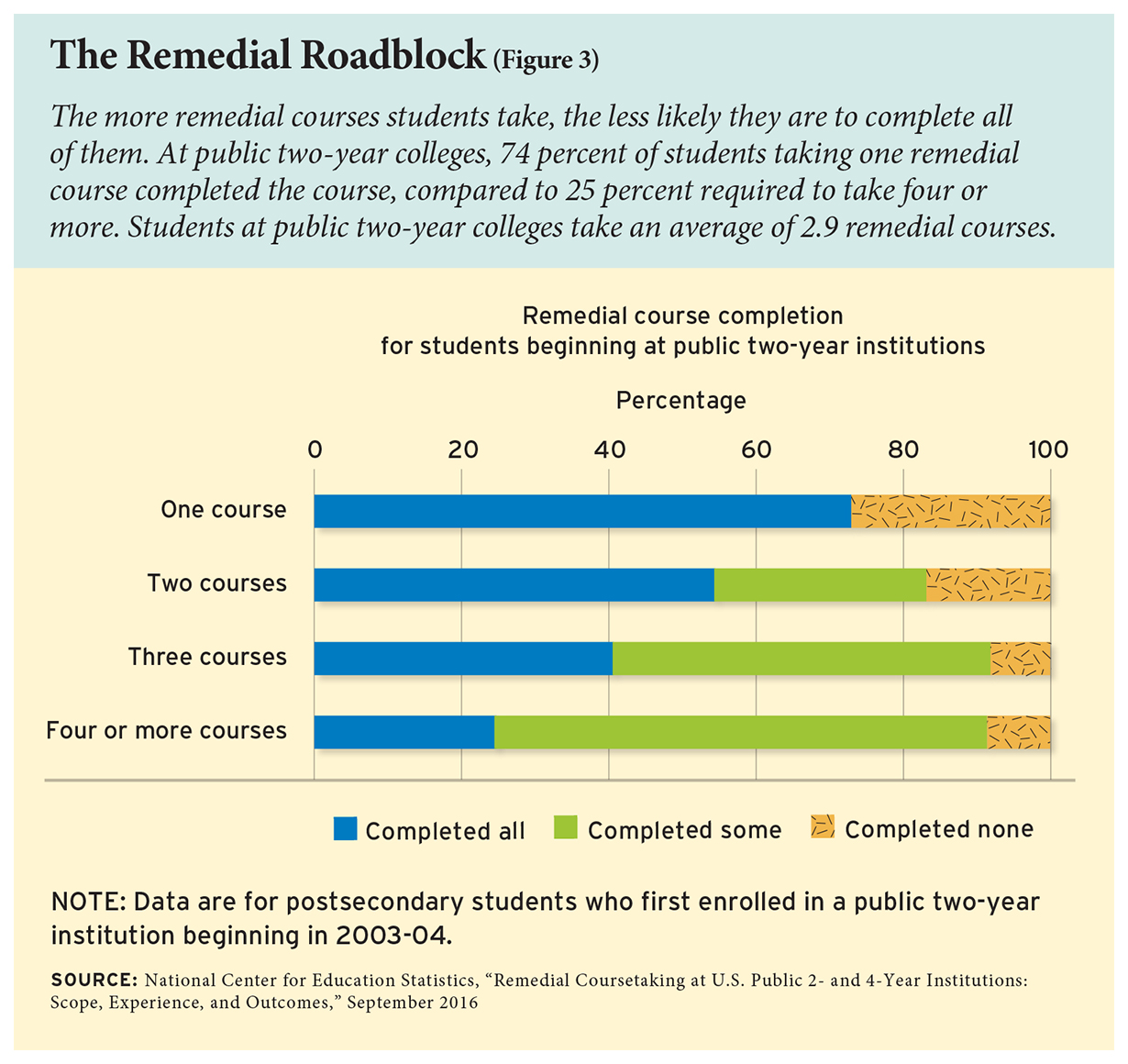
Redesigning Remediation
There’s another question at hand: whether the placement are effective measures of readiness.
A 2012 study noted that while great amounts of research had been done to determine the validity of ACT and SAT tests, much less scrutiny had been imposed on placement exams. Most studies of the then-dominant Compass, an ACT product, and ACCUPLACER, a product of the College Board, “have been conducted by the test makers themselves,” wrote researcher Judith Scott-Clayton. She concluded that using a combination of indicators, including high-school transcripts, would be more effective in sorting out students, leading to higher percentages of students reaching and passing college-level course work faster. ACT discontinued the Compass test in December 2016.
Other research has raised questions about the value of remedial classes, regardless of placement-test results. A study of three community colleges at the City University of New York (CUNY) found that students who were slated to take remedial classes based on their test performance did better and were more likely to persist in school if they were enrolled in credit-bearing classes right away (see “Reforming Remediation,” research, Spring 2017). And another study showed that as many as 18 percent of students referred to remedial math courses based on test results and 29 percent of students referred to remedial English could likely succeed in college-level courses.
About one in four community colleges nationwide is experimenting with how they assess and deliver remedial course work, according to Davis Jenkins, a senior research scholar at Columbia’s CCRC.
North Carolina and California are among the states backing away from using a single test to assess whether a student needs to take remedial courses. North Carolina has used a “multiple measures” approach since 2013, in which community colleges use ACT or SAT scores to determine placement. Students with a high-school GPA of 2.6 or higher and at least four years of math, including one course above Algebra II, are automatically placed into credit-bearing classes. A recent study found that students evaluated in this way earned a “C” or better in so-called “gateway” math and English courses at higher rates than students who had been evaluated by a college-placement exam.
Before the changes, “students were told, ‘You gotta do this placement test,’” said Lisa Chapman, chief academic officer for North Carolina’s 58 community colleges. “It was one thing checked off a list. And the problem was, students would go on a Monday and expect to enroll on Tuesday. A lot of times … information wasn’t shared with them so that they understood the entrance exam and what it meant.”
Other fixes include combining remedial reading and writing into a single “accelerated” course, by shortening two semesters into one, for example. At Chabot College in California, students in such a course were 29 percentage points more likely to enroll in college-level classes than others who were not. In math, a yearlong class called “Statway” combines remedial and college-level content. Among students at 18 community colleges that introduced the class, 48 percent completed credit-bearing math classes in a year, compared to 6 percent of students enrolled in remedial math.
Then there is co-requisite course work, in which students enroll directly in college-level courses and separate, supporting classes at the same time, occasionally taught by the same teacher. Tennessee has gained a lot of attention for results obtained in several pilots using this method since 2014, followed by a statewide launch. In the program’s first year, 51 percent of students in co-requisite math classes got credit for college-level math in their first semesters, compared to the previous tally of 12 percent reaching the same goal within a year of taking remedial course work. States including West Virginia, Indiana, and Colorado have reported similar successes.
An “Open” Question
These changes, however, don’t necessarily capture the tradeoff in offering open-access community colleges.
Several states have looked to a different sort of policy fix in boosting student success: outcomes-based funding. In Tennessee, 85 percent of base funding depends on a series of outcomes, including degrees and credentials earned, transfers, and the number of students who reach “momentum points,” such as completing remedial education or getting a job. The state has experienced an increase in certificate and associate’s degree completion rates in its community colleges, but how much of that is due to outcomes-based funding is unclear; it had already implemented changes in its K–12, assessment, and remedial course work when outcomes-based funding was introduced.
Many advocates approach such rules with caution. Some worry that community colleges under pressure to produce degrees would lower their standards. Others fear that schools would avoid enrolling students who graduate high school with very low academic skills, such as the aspiring college student who scores at a 6th-grade reading level. But is college even the best choice for that student?
This question bangs against the open-door credo at the heart of the community-college mission, and many advocates balk at the notion that some students may never catch up. “I would never go to the idea that ‘college is not the right choice’ for certain students, based on 50 years of experience,” said Kay McClenney, founding director of the Center for Community College Student Engagement (CCCSE) at the University of Texas at Austin.
Evelyn Waiwaiole, CCCSE’s current executive director, allowed that “maybe community college isn’t right for some people”—but she was careful to add a caveat that more research must be done, given the success of recent reforms. “Those who place three levels down … we’re not talking about them,” she said. “We haven’t done research on the lowest levels.”
One educator who is open to the idea is Jane Arnold, a veteran remedial English professor at SUNY Adirondack who has taught both Essor and Newman-Heck and is preparing to retire. Remedial courses can be very “frustrating,” she said.
“It’s frustrating for students, who waste so much time and don’t get the results they want. It’s frustrating for administrators, who are under pressure to graduate students faster … and tend to water down the curriculum, since they see students as customers who are always right,” she said. “But I’m not selling credits. I want to help students learn. So it’s frustrating for faculty as well.”
Helping students or adults with weak academic skills should involve a detailed review of possible options for educational and career advancement—something broader, yet more specific than opting in to community college as a default. Perhaps a student’s next step could be earning a technical certificate or completing a community-based program that leads to a job, she said.
Figuring out what those other options should look like may be the key piece of the puzzle to help students like Essor and Newman-Heck so that enrolling in a community college is truly a choice rather than the only viable path to advancement.
“We could be telling students, ‘We’re sorry—the system screwed up really badly, and you got here, but you’re not ready for this yet … It’ll take x amount of years to get your associate’s degree,” she said. “‘Or, there are these other options.’ … It doesn’t have to be community college.”
Timothy Pratt is an independent reporter based in Atlanta.
This article appeared in the Fall 2017 issue of Education Next. Suggested citation format:
Pratt, T. (2017). The Open Access Dilemma: How can community colleges better serve underprepared students? Education Next, 17(4), 34-41.


